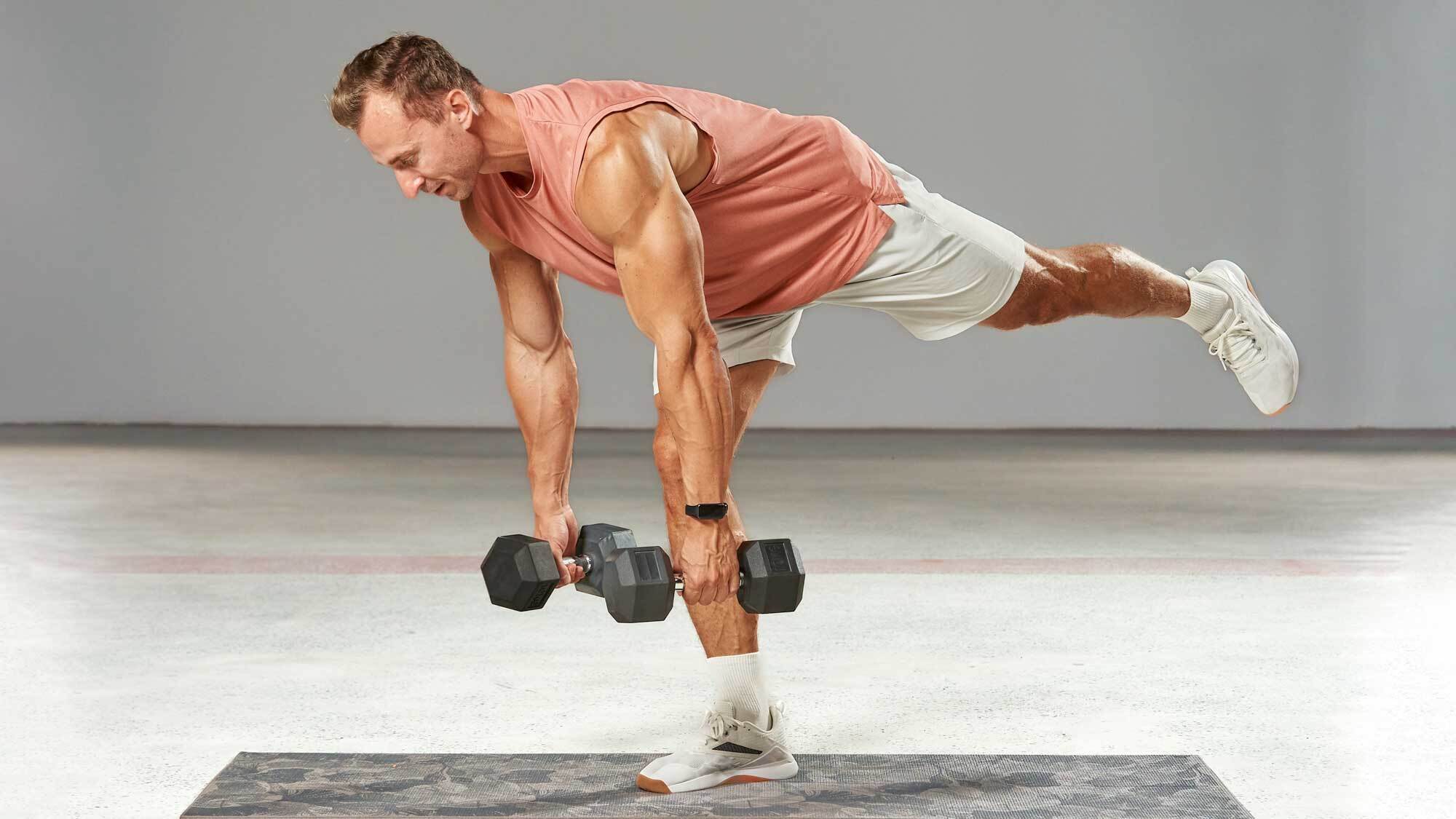
Have you thought about the different phases of exercises you do in the gym? Take the humble squat, for example. You lower into the squat, pause at the bottom, then drive upward to stand; these three phases are called eccentric, isometric and concentric muscle contraction, and if your goal is to build muscle or strength in the gym, you need to know more about them.
Most of the time, our focus as gym-goers is on shifting weight at the most resistance — lifting a weight up, standing from a squat, or pulling ourselves over the bar during a pull-up — but it turns out that each movement phase can benefit you, your strength gains and muscle hypertrophy (that’s muscle growth).
Below, and with the help of experienced strength coaches, I cover everything you need to know about eccentric, concentric and isometric training, the benefits and how to train for each movement type.

What is the concentric phase of a rep?

When you perform a repetition of any exercise that requires flexion and extension (in other words, movement), there’s a concentric phase of the rep. This is when the muscle shortens during contraction.
“Concentric movement refers to the phase of muscle contraction where the muscle shortens while generating force,” says Rowan Clift, training specialist for the workout app Freeletics.
“This happens when the muscle overcomes resistance, typically during the lifting phase of an exercise. Concentric exercises are crucial for building muscle strength, improving power and training muscles to exert force.”
For example, when you perform a biceps curl, the concentric movement occurs when the biceps contract to lift the weight toward your shoulder, shortening the biceps in response. During a push-up, the concentric phase occurs when pushing upward and extending the elbows, and when you perform a lat pull-down, the “lifting phase” refers to pulling the bar downward.
What is the eccentric phase of a rep?

The eccentric phase may garner less attention, but it shouldn’t — it could be the best (badly kept) secret to building muscle, stability and control.
“Eccentric movement refers to the phase of muscle contraction where the muscle lengthens while under tension. This occurs when a muscle is actively resisting a force whilst being stretched,” explains Clift. As the muscle lengthens, the force of contraction is less but your muscles still provide force to control the movement, otherwise, you’d simply drop the weight.
“In practical terms, eccentric movements happen during the 'lowering' phase of an exercise. They are important for muscle strengthening, as they can create more muscle damage in a controlled way, leading to greater growth and adaptation during recovery. They are also beneficial for improving flexibility, joint stability and injury prevention.”
Think of lowering the weight during a deadlift or lifting the dumbbell toward your shoulder during a triceps kickback.
What is the isometric phase of a rep?
Isometric contraction occurs without movement, like a plank, or a pause during an exercise, like a squat and hold; this places muscles under tension without shortening or lengthening.
When programming exercise tempo during workouts, coaches will attribute numbers to the phases of an exercise. For example, a bicep curl programmed at a 4-1-4-1 tempo means lifting the weight for four seconds (concentric phase), pausing for one second (isometric), then lowering the weight (eccentric phase) for four seconds, then pausing again for one second.
Coaches can therefore control the speed of an exercise, placing muscles under tension for more or less time, depending on workout goals.
“An isometric contraction is a type of muscle contraction where the muscle generates force without changing its length,” says Clift. “During an isometric contraction, the muscle is engaged and producing tension, but there is no movement of the joint or change in the angle of the muscle. Examples of isometric contractions include a plank, wall sit, or even holding a weight.”

Many isometric exercises are low-impact and can be used for injury rehabilitation. “Isometric exercises are useful for building muscle endurance, improving stability and strengthening muscles without the need for dynamic movements” adds Clift. "They are also often used in rehabilitation settings to avoid aggravating injuries while still maintaining muscle strength."
When deciding between isometric and isotonic exercises (dynamic exercises), remember isotonic movements still have that isometric phase. If you want to increase time under tension (how long the muscles are under contraction during an exercise), isometric phases are a great way to do it.
“Gymnastics is a prime example of isometric contractions,” adds Rich Marchant, a leading CrossFit and functional fitness coach who runs Black Swan Training. "Athletes often hold positions where muscle fibers are activated, but the joint angle and muscle length remain static.
"Think of a gymnast holding a planche or an iron cross on the rings. In these movements, muscles like the shoulders, core, and biceps work hard to maintain stability without shortening or lengthening."
Marchant explains isometric exercises can also strengthen intra and intermuscular coordination — how well muscles within a muscle group (intra) or between muscle groups (inter) work together, as they require “high levels of muscle recruitment to maintain tension and stability.”
Over time, this can improve strength, endurance and neural activation — vital for holding static positions under stress.
Concentric vs eccentric vs isometric training: Benefits
Focusing on all three phases of movement can help you build strength, muscle, power and control during exercise. But like anything in life, different goals require different training stimuli, so you might focus on adapting your training programs accordingly.
"The benefits of eccentric contractions include muscle growth or hypertrophy…because they cause more microscopic muscle fiber damage than concentric contractions," says Clift. "This damage is key for muscle growth, as the body repairs and strengthens muscles during recovery.
"Another benefit is enhanced strength…allowing you to handle heavier loads. It can also improve flexibility, helping stretch muscles under tension, which can enhance muscle flexibility over time."
Eccentric training even improves muscle control and coordination as your body learns to resist gravity or external force during the movement.
"The benefits of concentric movements include enhanced muscle strength and power," adds Clift. "Concentric contractions are responsible for the active movement in most exercises, helping develop explosive strength...they can also improve muscle endurance over time and aid functional movement."

Think about any dynamic actions you do during the day, like lifting, climbing, pushing, or even sprinting and weightlifting in a sports setting — all require concentric contractions. “They are also beneficial for burning calories, requiring more energy than eccentric movements, making them effective for fat loss and metabolic conditioning,” he says.
You’ll find eccentric and concentric phases everywhere: running and quickly slowing to a stop, controlling the descent of a hill and climbing that same hill, or even changing directions while you walk. Stopping and starting — your body should be able to perform all these movements efficiently.
Isometric contractions can improve endurance and stability for your core and postural muscles, too. “They also offer benefits for joint stability, strengthening muscles without moving the joints,” adds Clift.
“This is especially useful for rehabilitation or injury prevention. Isometric training helps strengthen muscles at specific joint angles. This is particularly useful for athletes or individuals who need to develop strength at points in their range of motion.”
By including more controlled eccentric movements and isometric exercises in your routine, you could strengthen connective tissues like tendons and ligaments, ultimately improving stability, balance and control.
Over time, that translates to making your concentric lifts stronger, which makes sense, right? If you can control the lowering phase of a squat better, you can be more powerful as you push to stand.
Concentric vs eccentric vs isometric training: How to train for each phase
“Each type of contraction offers distinct advantages, but incorporating all three into a training regimen provides a comprehensive workout that enhances strength, endurance, stability and injury prevention,” Clift says.
He recommends a typical strength training program that includes a concentric phase for muscle strength and functional power, an eccentric phase for muscle growth, flexibility, and tendon strengthening and isometric holds for stability, endurance and joint support.
For eccentric training, focus on slowing down the lowering phase of an exercise, like lowering a barbell during a bench press for three to five seconds, and use heavier weights for eccentric-only training. “I’d recommend this type of training once or twice a week as it causes more muscle damage, and as such, recovery time is longer,” he says.
Marchant agrees, adding, “Tempo training is an excellent method…this extended time under tension increases control and strength while minimizing injury risk. Eccentric work can also be incorporated into exercises like squats, where the focus is on a slow descent, building resilience in the muscles.”
If you choose a heavier weight for eccentric loading (most people can handle more weight here), you may need a spotter to help you lift it during a concentric phase.
For concentric training, Clift says to focus on the lifting phase. “In strength training, this is typically the portion where you're moving the weight against gravity. Since concentric contractions are part of most dynamic exercises, they can be trained in every strength session, especially when focusing on lifting heavy or working on explosive movements.”

“Dynamic work, such as lifting lighter weights with fast, explosive movements, emphasizes the concentric phase,” adds Marchant. “Doing medicine ball throws or barbell jumps with light loads can improve power and speed…particularly useful for athletes who need quick bursts of force, as it trains the muscles to contract rapidly and powerfully.”
Equally, you can go heavy on the concentric phase and focus on maximizing force exertion during the lift to build power.
Standalone isometric exercises during warm-ups or cool-downs are great or incorporate holds in tandem with dynamic exercises, like pausing at the bottom of a bench press or squat. Several times a week is enough (anything from once to three times) to notice improvements.
“Gymnastic movements like holds (planks, L-sits, or wall sits) can be introduced to strengthen tendons and ligaments,” Marchant recommends. “These exercises can be held for longer durations (30 seconds to a minute or more) to build muscular endurance and connective tissue strength. Isometrics can also be integrated into strength programs, where you hold a squat or push-up position for a few seconds to increase tension and stability in the joints.”
Concentric vs eccentric vs isometric training: Which is better for hypertrophy?
“For muscle growth, eccentric movements are generally considered more effective than concentric or isometric contractions,” Clift reveals. “However, all three types of contractions can contribute to hypertrophy and the best approach often involves a combination of them.”
Eccentric training typically causes greater muscle damage, signaling the body to repair and grow muscles stronger and larger. “Eccentric movements also increase time under tension…the longer muscles are under tension, the more they are stimulated to grow.”
As you can typically handle more weight during the eccentric phase, you can apply greater loads to the muscle. “Some studies suggest that eccentric-only training with heavy weight is very effective for muscle growth," Clift says.
Marchant agrees, adding, “Concentric movements, while they cause more immediate fatigue, are crucial for the overall strength gains needed to support hypertrophy.”
Bottom line
“Ultimately, a well-rounded training program that incorporates all three types of contractions — eccentric for control and muscle damage, concentric for power and strength, and isometric for stability and tendon health — will be the most effective for hypertrophy, injury prevention and long-term strength gains,” Marchant says.
Isometric exercises won’t build maximal strength and muscle mass, but they can help bridge the gap by strengthening tendons and ligaments as muscles grow, improving how the body handles load.
If you’re working toward a one-rep max or enjoy powerlifting, concentric training might be more the focus, recruiting your fast-twitch muscle fibers, responsible for exerting power and force.
Those new to weight training may add eccentric-focused sessions to help build great technique and foundational growth and improve the mind-muscle connection. However, it can take longer to recover from eccentric sessions, increasing the likelihood of DOMS (delayed-onset muscle soreness).
While building a training program, schedule rest and recovery to avoid overtraining and focus on progressive overload principles to ensure you build gradually and safely. I always recommend working with a coach to optimize your schedule and plan training sessions, incorporating the methods above into your routine accordingly.
Periodization is the best way to do this, splitting a training plan into blocks — usually four weeks per block with a different focus throughout. It’s the best way to track, measure and build progress and adds a system you can easily follow.
Depending on your goals and ability, most of your time might be spent optimizing all movement at regular tempos, while you may add specific training (concentric-only, eccentric-only, or tempo training, for example) into certain weeks. Just remember, the more effectively you can handle all three phases, the better you'll perform an exercise.
More from Tom's Guide
- Here are the best ways to build muscle without lifting heavier weights for inspiration on drop sets, weights, reps and periodization
- Hypertrophy vs strength training: Which is better for building muscle?
- I’m a personal trainer — here’s what agonist vs antagonist muscle groups really mean
Sign up to get the BEST of Tom's Guide direct to your inbox.
Get instant access to breaking news, the hottest reviews, great deals and helpful tips.

Sam Hopes is a level 3 qualified trainer, level 2 reiki practitioner and senior fitness writer at Tom's Guide. She is also currently undertaking her Yoga For Athletes training course. Sam has written for various fitness brands and websites over the years and has experience across brands at Future such as Live Science, Fit&Well, Coach, and T3.
Having worked with fitness studios like F45 and Virgin Active, Sam now primarily teaches outdoor bootcamps, bodyweight, calisthenics and kettlebells. She also coaches mobility and stretching-focused classes several times a week and believes that true strength comes from a holistic approach to training your body.
Sam has completed two mixed doubles Hyrox competitions in London and the Netherlands and finished her first doubles attempt in 1:11.


